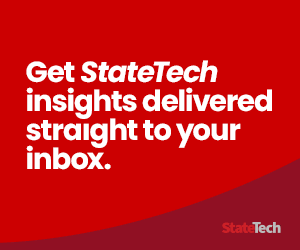As the pace of digital transformation quickens, state and local government agencies are under increasing pressure to modernize operations, heighten efficiency and enhance constituent services. Microsoft Teams, a popular choice for its basic communication features, such as cloud calling and video meetings, offers untapped potential to revolutionize how agencies collaborate and deliver services.
More than just simple messaging, Teams offers a robust platform for integrating business applications and automating workflows so that governments can become more efficient and responsive.
Like many organizations, government agencies tend not to utilize Teams to its full capability, considering it primarily a communications tool. However, Teams is a secure, centralized and collaborative workspace in which departments can streamline tasks, automate document approval, obtain feedback and manage human resources — all fundamental functions for the public sector. With proper planning, Teams can serve as a foundation for modern government operations.
Click the banner below for guidance around optimizing collaboration environments.
Working to Coordinate Across Agencies
Effective task management is especially important in government, particularly for cross-departmental or interagency projects. Traditional approaches that rely on email and spreadsheets typically lead to miscommunication, delays and a lack of transparency. Teams, with the inclusion of tools such as Microsoft Planner and To Do, provides one place to create, assign and track tasks in real time.
For example, a city’s public works department managing a road construction project can use a dedicated Teams channel to:
- Set clear goals and assign tasks with deadlines
- Visually track progress in Planner’s board view by task status
- Keep communication centralized within each task card
- Attach supporting materials such as permits and blueprints directly to tasks
This organized method improves accountability, reduces errors and speeds project completion, ultimately delivering more effective services to constituents.
RELATED: Transform your team's productivity with CDW and Copilot+ PCs.
Agencies Can Automate Workflows
Manual document approval workflows in government — at the budget, license and proposal levels — are often time-consuming, error-prone and difficult to audit. Teams, in tandem with Microsoft Power Automate, enables agencies to automate such workflows efficiently.
Consider a Department of Motor Vehicles office processing driver’s license applications that require multiple approvals. That workflow could include:
- Accepting applications via Teams-integrated forms
- Routing documents via Power Automate to the appropriate reviewers based on predefined rules
- Sending real-time notifications to approvers, who can approve directly from within Teams
- Tracking progress transparently for review by all stakeholders
- Creating an immutable audit trail to support regulatory compliance
This not only speeds up decision-making but also improves accuracy and reduces administrative loads.
320 million
The number of Microsoft Teams users globally in 2024
Source: businessofapps.com, “Microsoft Teams Revenue and Usage Statistics (2025),” March 24, 2025
Microsoft Forms Helps Engage Citizens and Staff
Taking citizen or team feedback is necessary for good governance. Paper surveys or mass emails are outdated and not very effective. Teams simplifies this by building polls directly into Microsoft Forms or third-party applications.
For instance, a city council may wish to seek public opinion on zoning changes. It can:
- Hold live polls via virtual town halls
- Post detailed surveys in channels within Teams
- Discover real-time analysis to inform decisions
This real-time feedback loop fosters transparency and civic engagement, and enables faster, more informed decision-making. Internally, polls enable agile employee feedback on business decisions.
DISCOVER: Save time and money on managing your Microsoft infrastructure.
Microsoft Teams Simplifies Onboarding
Government HR departments struggle to onboard new staff, track personnel information and announce policies. Teams offers centralized tools to simplify these tasks.
For example, a state agency bringing on new employees can:
- Provide dedicated channels for new employees to view welcome packages, policies and FAQs
- Conduct virtual orientations using video, chat and shared documents
- Broadcast policy updates or training sessions from a central HR portal
- Integrate with HR systems to process leave requests and track submissions
This improves the onboarding process, simplifies communication and reduces HR workload by minimizing email and paperwork.
How Agencies Are Expanding Teams’ Impact
Here are some routine tasks that government agencies can tackle with Teams:
1. Internal announcements
Rather than using mass emails, Teams channels can be used by agencies to broadcast announcements and policy changes. Structured by department or subject matter, this provides timely delivery and simple referral.
2. Customer service
While it’s not a complete customer relationship management system, Teams enhances both internal and external service provisioning. IT help desks or HR departments can establish special channels for support issues, develop solutions collaboratively and monitor resolutions. This is further improved by integration with ticketing systems.
Click the banner to sign up for the StateTech newsletter for weekly updates.
3. Events management
Whether for a public forum or an internal training session, Teams can support the whole event lifecycle, including:
- Planning with committees using document- and task-sharing
- Conducting virtual events using Teams Live Events
- Tracking registration and distributing event materials using external integrations
4. Document management
Teams offers integration with SharePoint and OneDrive to support advanced document management, including real-time co-authoring, versioning, secure sharing and easy retrieval. For agencies that handle massive amounts of sensitive data, this is essential.
Building a Future-Ready Government
Microsoft Teams is more than a virtual meeting room — it’s a catalyst for public sector change. By taking full advantage of its capabilities, state and local governments can transform collaboration across departments, speed service delivery and engage with constituents more effectively. From automating workflows to enhancing transparency and coordinating large projects, Teams facilitates a more responsive, cohesive and citizen-focused government.
Modernizing with Teams isn’t just about new technology, it’s also about changing the way government works in the digital age. Organizations that fully leverage its features will not only improve operational efficiency but also build stronger, more responsive relationships with the communities they serve.













